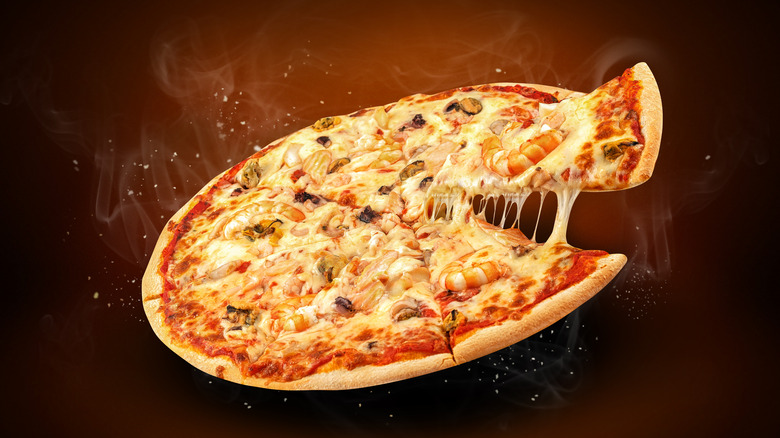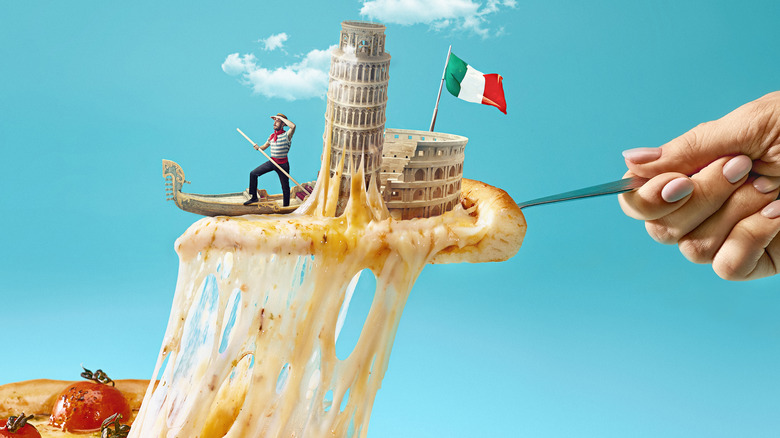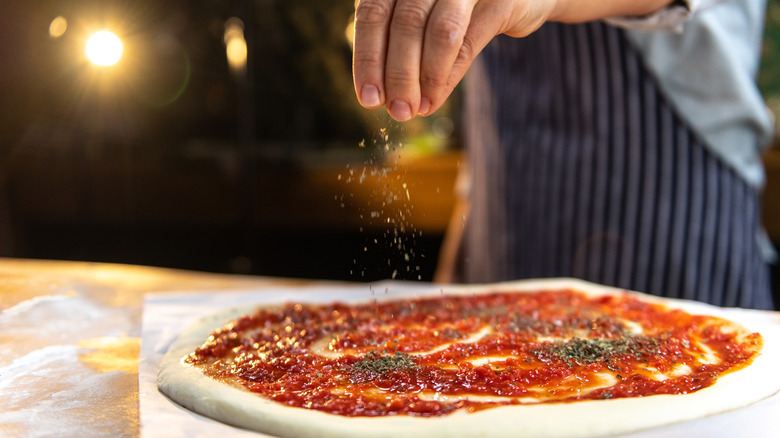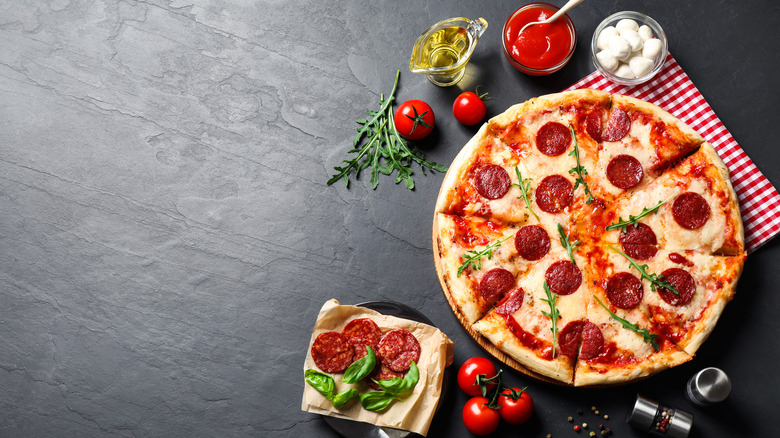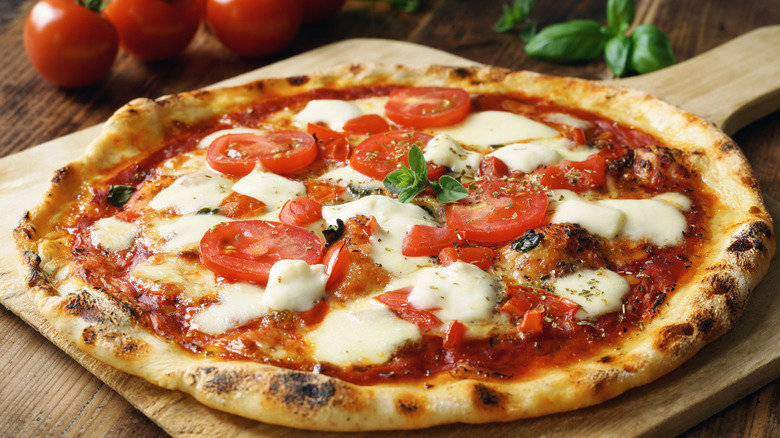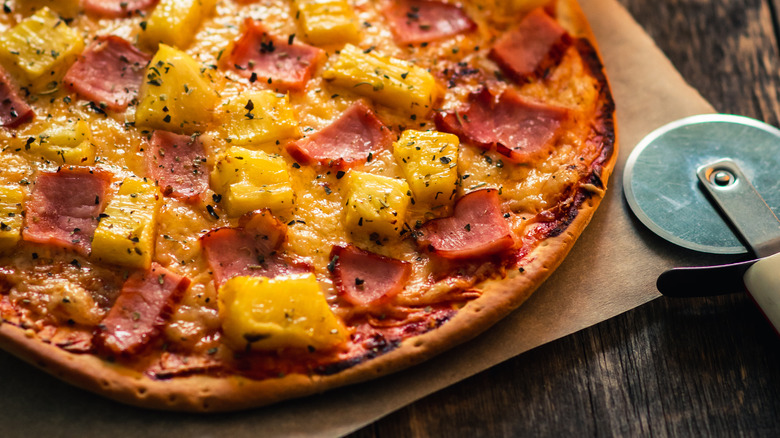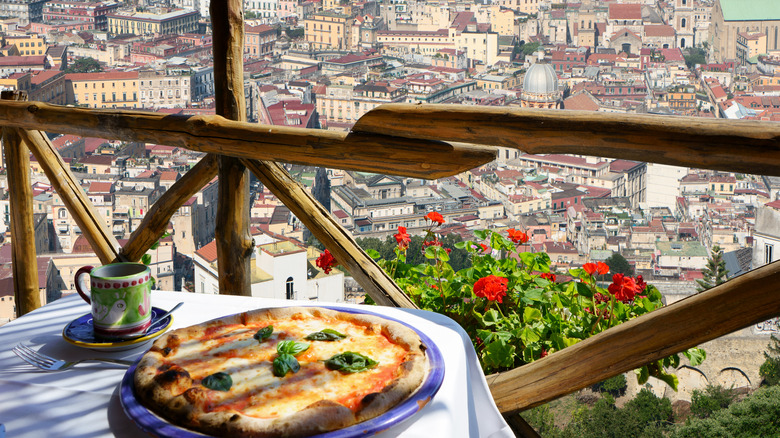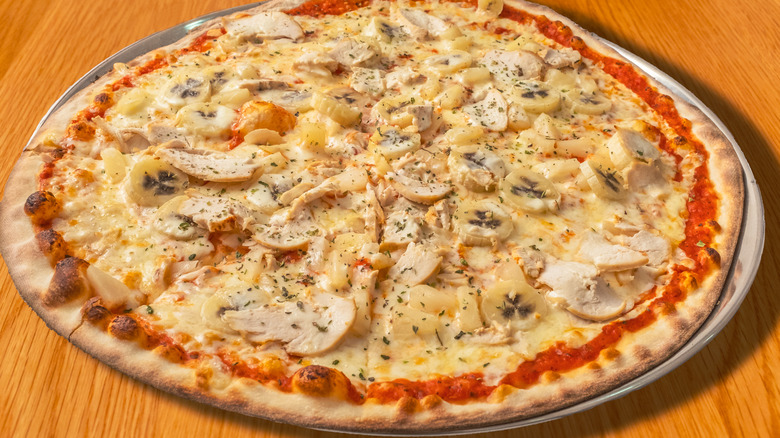Pizza Myths You Probably Fell For
It's no secret that pizza is wildly popular. No one ever says, "No, thanks," to pizza night, and whether you stop at your favorite local pizza place, order takeout, have it delivered, or make your own, it's tough to go wrong. Even leftover pizza is great, and it's the rare meal that's just as good the second time. It's so versatile that there's an option everyone's going to love, and it's pretty much perfection on a platter. Because pizza is so widely popular, it's one of those foods that we think we just know. We know what's good, what's bad, we know that tomato sauce can make or break the finished product, and we know which type is our favorite. We have our pizza-ordering hacks, our favorite ways to reheat it, and there's no mystery here, right?
Hold on. It turns out that if you do some digging, a lot of the so-called "facts" we think we know about our favorite dinner are just downright wrong, and there are some biggies in here. Let's start with some of the basics: We all know that pizza comes from Italy, right? Actually ... not so fast.
We know, right? Let's debunk some pizza myths in a way that will definitely give you some fascinating tidbits to share over the next pie you have ... no matter where you are or who you're sharing it with.
Pizza is Italian in origin
Everyone knows that pizza is Italian, but here's the thing: ZMEScience says that statement isn't precisely true.
Pizza is essentially a flatbread crust with toppings, right? Well, that idea goes back to the Persian army and the 6th century B.C. Soldiers under King Darius I came up with a pretty ingenious method of making their meals not-so-boring: They would cook a flat piece of bread on their shields, then add toppings. Who would have thought that the original pizza peel was a shield? It brings a whole new meaning to "the heat of battle."
That idea was picked up by the Greeks. They went head-to-head with the Persians quite a bit, and while there was a ton they didn't see eye-to-eye on, they knew a good meal when they saw it. Before being introduced to the Persian way of doing things, they tended to bake things like seasonings and olive oil into their bread, but eventually started making the round, flatbreads and adding toppings. It even gets a mention in the "Aeneid"!
There's another part to this, too. Pizza has evolved a lot from those days of baking bread on shields, and now, we most strongly associate it with origins in Naples. Italy, right? Not so fast. When Naples was founded, it was actually a Greek colony. Even up until the early 1800s, Naples wasn't a part of Italy, they were an independent nation with people who relied on pizza as a staple food.
Pizza was always universally popular
Pizza is almost shockingly popular: According to The Washington Post, Americans eat the equivalent of 100 acres of pizza each and every day. It wasn't always this way, though, and originally, pizza was sort of the opposite of popular.
History Today says that by the middle of the 18th century, pizza had taken on a shape that we'd recognize today. It was sold on the streets of Naples, and it fed a class of people called the lazzaroni. They weren't just working-class, they were the tens of thousands of Naples residents who struggled to put food on the table — which is where pizza came in. Vendors would cut a slice as big or as little as a person could afford, and that person could eat on the run. And that's exactly why they weren't popular. Pizza was the food that the poor ate when they couldn't afford anything else, and it was the kind of food that "respectable" people just tried not to acknowledge. When they did, they didn't have much nice to say.
Samuel Morse — of the Morse code fame — reviewed pizza like this in 1831: "[It's a] species of the most nauseating cake ... covered over with slices of pomodoro or tomatoes, and sprinkled with little fish and black pepper and I know not what other ingredients, it altogether looks like a piece of bread that has been taken reeking out of the sewer."
Needless to say, pizza didn't impress for a long, long time.
Tomato sauce was always a crucial pizza ingredient
Today, it goes without saying that a good tomato sauce is a must on any pizza (white pizza being an exception). That definitely wasn't always the case, and this is a fascinating bit of history.
History Today says that most of the earliest pizzas were topped with things like herbs and mushrooms. By the time the lazzaroni of Naples were eating it, they leaned heavily on widely available and cheap toppings. A pizza with salt, lard, and garlic was traditionally the cheapest version, but there were also pizzas made with horse's milk cheese and fish. It wasn't until the 1800s — fairly recently in the long history of pizza — that tomatoes were included ... and it's for a pretty sad reason.
Tomatoes were still fairly new in Europe, and many people refused to eat them out of a fear that they were deadly. ZMEScience says there was something to that: The problem happened when tomatoes were eaten off pewter plates, which was common enough among the upper classes. The acidic tomatoes would draw lead from the plates and poison those who ate them, and it wasn't the lead that was blamed, it was the tomatoes. That made these New World imports incredibly cheap, so they became an affordable topping for the pizza of the poor — who didn't have fancy pewter plates, and could safely eat tomatoes. Bottom line? Pizza without tomatoes has been around longer than pizza with them.
Pepperoni is definitely Italian
When it comes to popular pizza toppings, pepperoni is up there. The New York Times says that in the short time leading up to the Super Bowl, Hormel alone sells around 40 million feet of the stuff. For comparison, that's about the distance from the North Pole to the South, if you went straight through the Earth's core. It's got to be Italian, right?
Absolutely not. Pepperoni is sort of like corned beef — just like corned beef was invented by Irish immigrants living in America and making the most of the meat they could afford, pepperoni was an Italian-American creation that only showed up in print for the first time in 1919. That's about the same time pizzerias started popping up in the U.S., too, and that's not a coincidence.
The who's who of true Italian meats and curing are pretty straightforward when it comes to saying what they really think of pepperoni. Michael Ruhlman is an expert in the field, and says pepperoni pizza is just wrong. "America," he says, "has a way of taking a good idea, mass-producing it to the point of profound mediocrity, then losing our sense of where the idea comes from." Ouch. Sorry, pepperoni-lovers.
There's an even stranger footnote, and that's the idea that it doesn't even really have that much in common with Italian sausages. Pepperoni is smoked, which makes it closer to European cousins found not in Italy, but in countries like Germany.
That story about how the queen loved Margherita pizza
One of the most often-told tales about the history of how pizza became popular involved the pizza Margherita. It is, of course, the story of how chef Raffaele Esposito made a few pizzas for Queen Margherita, and she loved the one with mozzarella and basil so much that it was named after her and became wildly popular.
Only ... it's not exactly true. At all.
Research done by Zachary Nowak of The Umbra Institute looked at the story in a historical context, and found that it's essentially something called fakelore: Folklore with a touch of truth. The king and queen were, indeed, in Naples in 1889 and confirming the part of the story that suggests she was sick of French food and wanted to try some of this pizza stuff is difficult, but other elements of the story have problems. Historians condemn the idea that the queen would summon a commoner to not only cook her food, but to make her the food of the poor — especially at a time when cholera outbreaks were a frequently deadly occurrence among the lower classes.
Perhaps most strangely, Esposito changed the name of his pizzeria to "Pizzeria of the Queen of Italy" six years before he reportedly served the queen, and there are no contemporary mentions of such a momentous event. What about the famous thank-you note? The seal isn't the official one, it's debated whether or not the person who signed it was even real.
Hawaiian pizza is, well, Hawaiian in origin
Love it or hate it, it's impossible to deny that Hawaiian pizza is a thing that exists. It might seem logical that it's a regional delicacy that spread across the globe while being fueled by hate and controversy, but it's pretty much the opposite of Hawaiian.
In 2017, Iceland's president said that he hated the idea so much that he wanted to ban pineapple on pizza outright, the CBC went straight to the source to see what he thought. They spoke with the then 82-year-old Sam Panopoulos, the inventor of the Hawaiian pizza. He made it clear what he thought of the president of Iceland: "When I was working on the pineapple pizza — he wasn't even born. ... I don't care what he does. He can say whatever he wants. He sells the fish over there, you know, that's all he does. So he has to put the fish on the pizza."
Panopoulos — a Greek immigrant living in London, Ontario — went on to say that he was in Canada when pizza was just becoming popular, heading north from cities like Detroit. He was making pizzas at his Satellite Restaurant (while experimenting with all kinds of toppings), and introducing Canadians to them in the late 1950s, but by 2017, he'd moved on to frozen pizzas. "I get sick and tired of making pizzas."
The BBC announced that he passed away the following year.
Pizza is a terrible breakfast food
We've all heard that breakfast is the important meal of the day, so grabbing a piece of leftover pizza as you run out the door — or roll out of bed — has a bit of a stigma attached to it. That's for college kids and people who had a bit too much fun the previous night, right? It's the sort of thing that adults who are good at adulting might scoff at, but here's the thing: They're completely wrong.
Nutritionist Chelsey Amer, MS, RDN, CDN told The Daily Meal (via Health) that it all has to do with the quality of most typical breakfast foods. A cup of the deceptively healthy-sounding Raisin Bran still has a whopping 18 grams of sugar in it, and that's not only one of the better cereals, it's still close to a person's daily recommended limits. A slice of cheese pizza, on the other hand, has more of the good stuff — like the protein that's going to help keep you feeling full until lunch.
Sure, it's not the best or healthiest option out there when it comes to breakfast, but it's nothing to scoff at, either. No sugar crash and a full feeling until lunch? Sign us up. The bottom line is you probably shouldn't do it every day, but there are much worse breakfast choices you could make. And if you make your own pizza, there are even some simple guidelines for making it healthier.
Returning WWII soldiers made pizza popular
Here's another bit of pizza folklore: It became popular in the U.S. when soldiers returning from World War II wanted more of this delicious dish they had overseas for the first time. It's even in the first few sentences of pizza's Wikipedia page, and here's why Wikipedia makes an iffy source: It's not true.
Pizza had been in the U.S. long before World War II kicked off. Paste says it came with Italian immigrants in the late-19th century, and pizza places were common throughout cities like New York. By 1905, people were perfectly aware of the fact that they could buy a piece of pizza for a nickel, and here's where it really got popular.
Once again, pizza became the food of the poor. When times got tough during the Great Depression, pizza recipes — with their few ingredients and versatility — became a go-to. Take it from people like Clara Cannucciari, the 90-year-old host of a popular YouTube channel. She used the platform to share her Depression-era recipes: Including, says Texas Hill Country, her pizza recipes.
University of Denver historian Carol Helstosky says (via The Washington Post) that while it's not clear just how pizza spread, World War II was unlikely to have played much of a role. Not only were supplies scarce under the nation's Axis-era fascist regime, but even if soldiers did get Italian pizza, it wasn't much like the pizza that had already come to America decades earlier.
American pizza is pretty much like the Italian kind
Anyone who has been to Italy and ordered a pizza knows that what they consider pizza and what Americans consider pizza is very, very different ... but unless you've been there, it's easy to assume that it's pretty much the same.
Tuscan Eats describes exactly what you're going to get when ordering a traditional pizza in Italy: a cracker-thin crust, a sauce made from tomatoes, olive oil, garlic, and oregano, and the choice of one or no toppings. Those are the basics, and of course, there are regional differences. But you're not going to find things like New York's big, floppy slices, or a stuffed crust pizza. The sauce is heavier on the herbs and less tangy than American sauces, and toppings? Let's just say you're not going to get a pizza that weighs as much as your head.
It's also worth noting that Italian pizza-makers take their craft very seriously. In 2015, Dany Mitzman wrote a piece for the BBC that described a very important and hard-earned lesson: They know what they're doing, and don't question. When Mitzman tried to order a marinara pizza with mozzarella and was told it didn't exist, the pizzaiola didn't appreciate being questioned — at all. A marinara pizza has tomato, garlic, and that's it. Outside of Italy, we might be accustomed to customizing to our heart's delight, but maybe don't try that in Italy. They're classic for a reason.
Nothing is weirder than pineapple on pizza
It's pineapple on pizza that's the make-or-break choice that people around the world use to judge a person's taste in food: When Gordon Ramsay tweeted "Pineapples are for fruit salads not Pizza!" the world was incredibly upset. So, surely that's the weirdest pizza topping that appears on a standard sort of menu, right?
Not by a long shot, and let's start with Sweden.
When bananas first made it to Sweden in 1944, the Swedes went absolutely mad for them — and yes, bananas remain one of their staple pizza toppings. Culture Trip says they use bananas like Americans use pepperoni — they're even on Hawaiian pizzas, and their banana curry pizza is pretty much a national treasure.
They're not the only ones that have a taste in pizza that looks odd to American eyes. There's also Russia's Mockba pizza, which comes with sardines, salmon, tuna, mackerel, and onions, and Japan loves their ocean-going toppings, too: eel and squid are favorites, says Mental Floss. It makes pineapple look positively ordinary.
